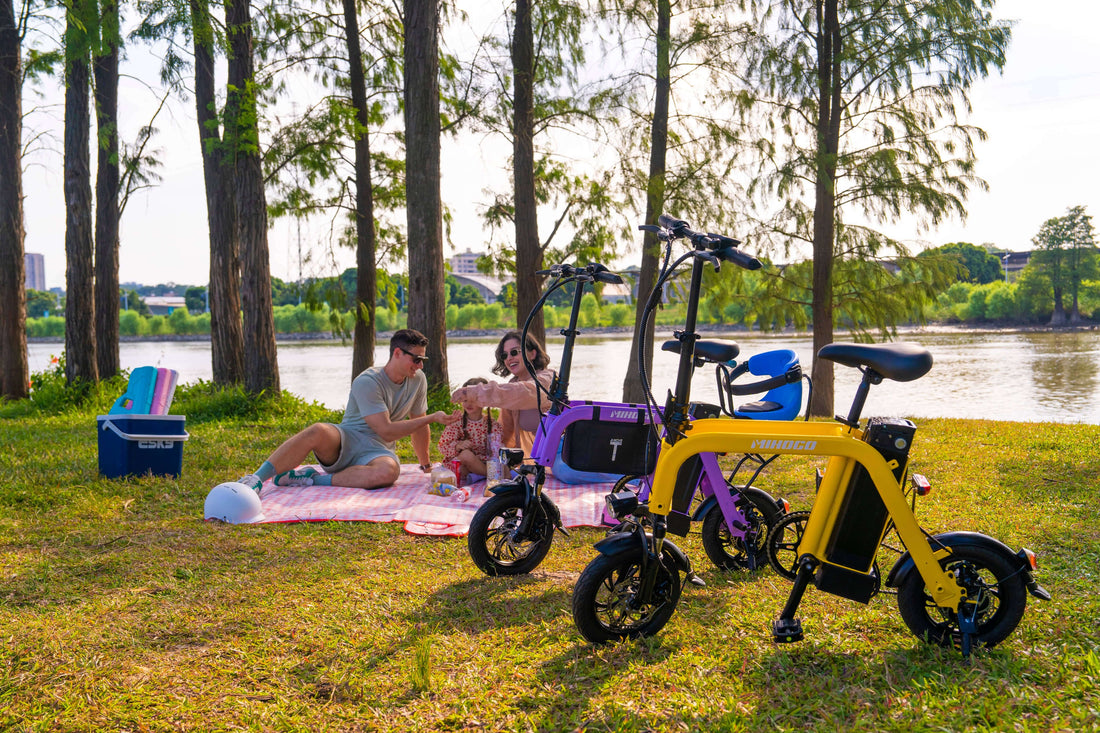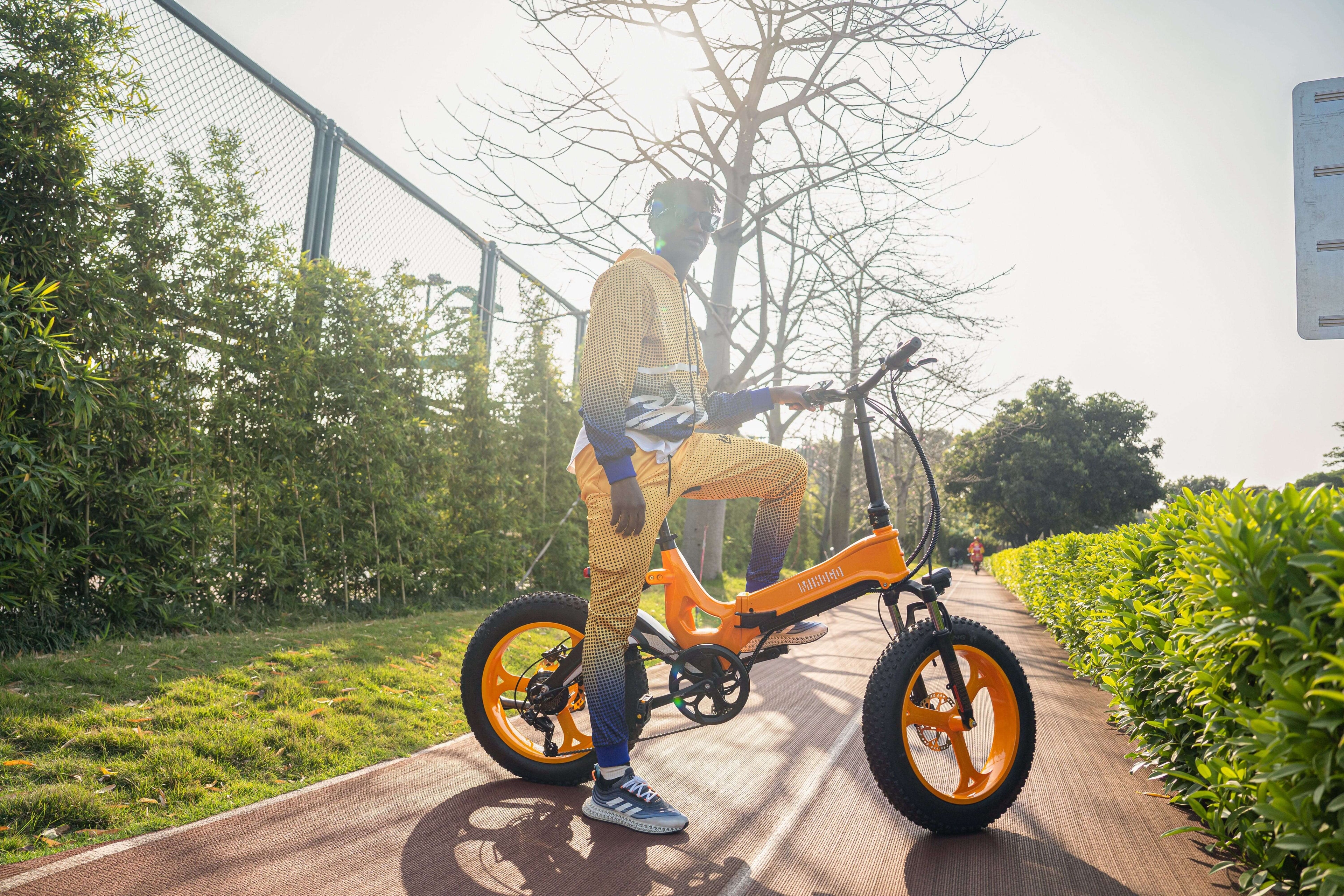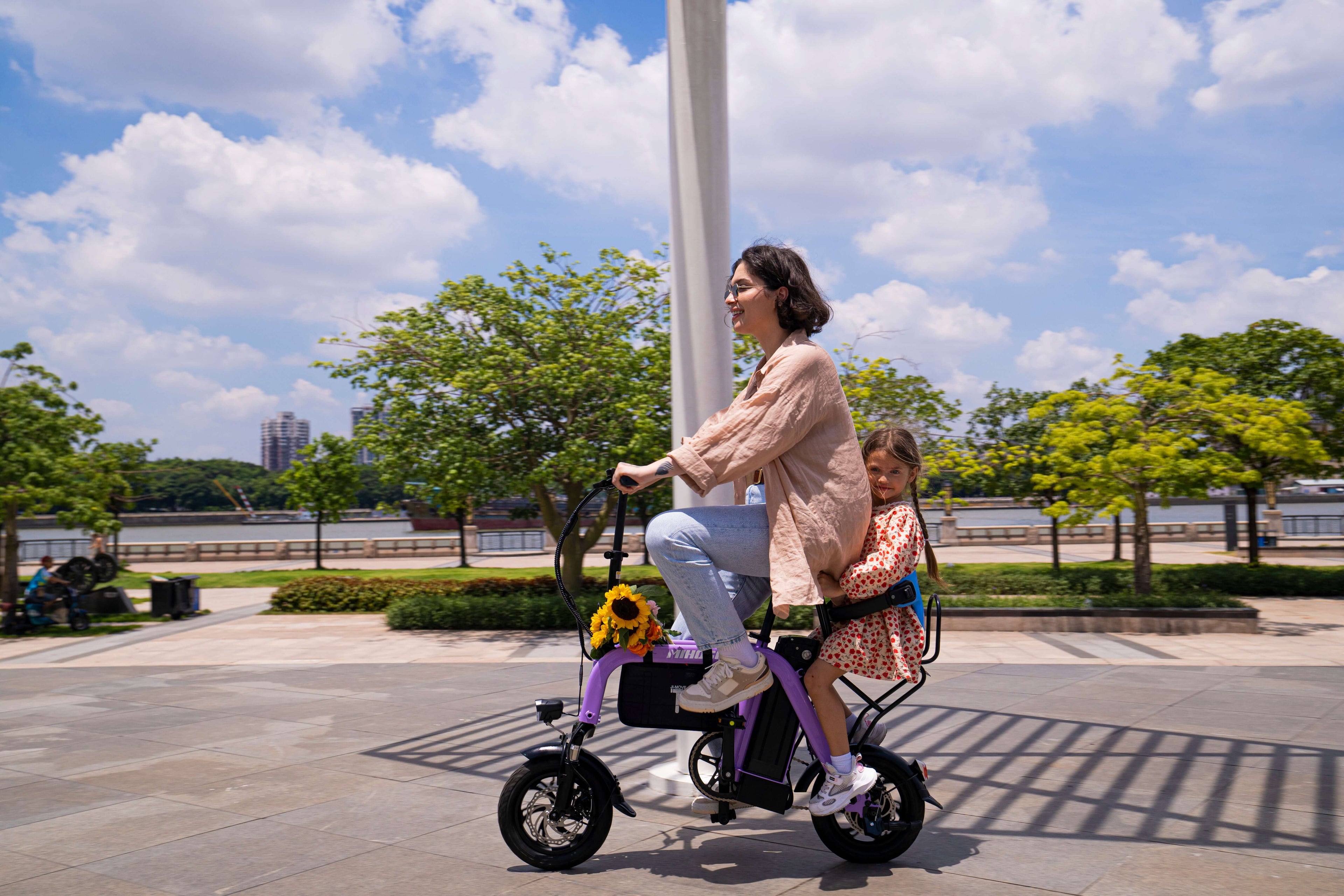Understanding Mihogo Hub Motor Systems by Model
Mihogo Air750 Max - High-Performance Carbon Integration
The Mihogo Air750 Max features a sophisticated 750W rear hub motor engineered for carbon fiber frame compatibility. This powerful system excels in paved urban environments, bike paths, and rolling hill terrain where its 121-mile range and 25MPH capability shine.
Ideal Terrain Performance:
- Urban commuting - Smooth power delivery for stop-and-go traffic
- Paved bike trails - Consistent assistance for recreational riding
- Moderate hill climbs - 750W provides ample torque for inclines
- Long-distance touring - Extended range supports all-day adventures
Motor Specifications: Brushless hub motor with regenerative braking, optimized thermal management
Mihogo ONE Utility - Heavy-Duty Workhorse Motor
The Mihogo ONE Utility incorporates a robust 750W hub motor designed for demanding cargo and utility applications. With its impressive 167-mile range, this motor handles heavy loads, delivery routes, and extended work applications while maintaining efficiency.
Ideal Terrain Applications:
- City delivery routes - Reliable power for commercial use
- Cargo hauling - Enhanced torque for loaded conditions
- Extended commuting - All-day power for professional riders
- Mixed urban terrain - Versatile performance across varied surfaces
Motor Features: Enhanced heat dissipation, reinforced bearings, commercial-grade durability
Mihogo RX 2.4 - Compact Folding Efficiency
The Mihogo RX 2.4 utilizes a space-optimized 500W hub motor engineered for portability without performance compromise. Despite its compact 40-mile range design, it delivers excellent power for urban mobility and storage-conscious applications.
Ideal Terrain Suitability:
- City commuting - Perfect for daily urban transportation
- Smooth pavements - Optimized for well-maintained surfaces
- Apartment living - Motor protection during frequent folding
- Public transport integration - Reliable performance after storage
Folding Considerations: Motor designed to withstand repeated folding cycles
Mihogo Mini - Entry-Level Precision Motor
The Mihogo Mini features an efficient 350W hub motor perfect for new e-bike enthusiasts. With 62 miles of reliable range, it's engineered for recreational riding and flat terrain applications.
Ideal Terrain Characteristics:
- Flat neighborhood streets - Optimized power delivery for level surfaces
- Park pathways - Quiet operation for recreational environments
- Beginner-friendly routes - Predictable power assistance
- Short commutes - Efficient for daily errands and light transportation
Motor Design: Simplified control system, maintenance-friendly construction
Essential Hub Motor Maintenance Procedures
Weekly Visual Inspection Protocol
Regular visual inspection prevents 80% of major hub motor failures. Implement this systematic approach:
External Motor Assessment:
- Check motor housing for cracks, dents, or impact damage
- Inspect cable connections at motor junction for looseness or corrosion
- Examine wheel alignment - Motor should center perfectly in dropout
- Listen for unusual sounds during manual wheel rotation
- Verify axle security - Nuts should be torqued to manufacturer specifications
Cable and Connector Maintenance:
- Clean connector pins monthly with contact cleaner spray
- Apply dielectric grease to power connections (prevents corrosion)
- Secure loose cables with zip ties to prevent chafing
- Inspect strain relief at motor exit point for wear
Monthly Deep Maintenance Tasks
Bearing System Care
Hub motor bearings require specific attention to prevent premature wear:
Bearing Inspection Process:
- Lift rear wheel and spin manually - should rotate smoothly
- Listen for grinding sounds indicating bearing deterioration
- Check for lateral play by gently rocking wheel side-to-side
- Lubricate accessible bearings with appropriate marine-grade grease
Signs requiring professional service:
- Grinding or rattling noises during operation
- Excessive wheel wobble or lateral movement
- Increased resistance when rotating wheel manually
- Metal filings or debris around motor housing
Thermal Management Systems
Overheating causes 35% of hub motor failures. Maintain optimal operating temperatures:
Cooling System Maintenance:
- Clean ventilation slots in motor housing monthly
- Remove debris from heat dissipation fins
- Monitor operating temperature - Should stay below 70°C (158°F)
- Avoid sustained high-load operation on steep inclines
Advanced Diagnostic Procedures
Hall Sensor Testing and Calibration
Modern Mihogo hub motors utilize Hall effect sensors for precise position feedback:
Hall Sensor Diagnostic Steps:
- Disconnect motor power completely before testing
- Access Hall sensor connectors (typically 5-pin configuration)
- Use multimeter to verify 5V supply voltage to sensors
- Test sensor output while manually rotating motor
- Look for consistent voltage switching as magnets pass sensors
Hall Sensor Maintenance:
- Clean sensor surfaces with compressed air monthly
- Check connector security - Loose connections cause erratic performance
- Verify proper alignment with rotor magnets
- Learn more about Hall effect sensors for deeper understanding
Motor Controller Interface Diagnostics
The controller-motor interface requires specific maintenance attention:
Controller Connection Inspection:
- Examine phase wire connections (typically 3-wire configuration)
- Test continuity between controller and motor phases
- Verify Hall sensor wire integrity using continuity testing
- Check for water ingress at all connector points
Preventive Maintenance Strategies
Environmental Protection Protocols
Hub motors face constant exposure to road debris, moisture, and temperature fluctuations:
Waterproofing Maintenance:
- Inspect seals around motor housing quarterly
- Apply marine sealant to cable entry points annually
- Avoid high-pressure washing near motor components
- Dry thoroughly after riding in wet conditions
Debris Protection:
- Install fenders to reduce water and debris exposure
- Clean regularly with soft brush and mild detergent
- Protect during storage with motor covers when possible
- Avoid salt water exposure - Rinse immediately if contact occurs
Performance Optimization Techniques
Gear System Maintenance (Geared Hub Motors)
Some Mihogo models utilize internal gear reduction for enhanced torque:
Gear System Care:
- Listen for gear noise during operation - Should be nearly silent
- Check for slipping under load acceleration
- Monitor for grinding sounds indicating gear wear
- Schedule professional gear service every 3,000-5,000 miles
Lubrication Schedule:
- Internal gears require specialized lubricants (PPL-1 or equivalent)
- Professional service recommended for gear lubrication
- Avoid over-lubrication which attracts debris
- Use only manufacturer-specified lubricants
Motor Longevity Optimization
Maximize your Mihogo hub motor's operational lifespan through proactive care:
Usage Pattern Optimization:
- Avoid frequent high-load starts from standstill
- Use appropriate assist levels for terrain conditions
- Allow cool-down periods during extended rides
- Maintain consistent pedaling to reduce motor strain
Troubleshooting Common Hub Motor Issues
Power Loss and Performance Degradation
Power-related issues affect 35% of hub motor problems, manifesting as reduced acceleration or intermittent operation:
Systematic Diagnosis Approach:
- Test battery voltage under load conditions
- Verify controller communication with motor
- Check Hall sensor functionality with diagnostic tools
- Inspect phase wire connections for resistance or shorts
Common Power Loss Causes:
- Worn brushes (in brushed motors) requiring replacement
- Hall sensor misalignment affecting position feedback
- Controller thermal protection activating during high loads
- Battery voltage sag under motor load conditions
Noise and Vibration Issues
Unusual sounds indicate developing mechanical problems requiring immediate attention:
Diagnostic Sound Analysis:
- Grinding noises typically indicate bearing wear
- Clicking sounds often suggest loose internal components
- Whining during acceleration may indicate gear system issues
- Rattling at standstill suggests damaged internal mounting
Vibration Troubleshooting:
- Check wheel balance and tire pressure first
- Inspect motor mounting for loose bolts or damaged mounts
- Verify rotor alignment within stator housing
- Professional diagnosis recommended for internal vibrations
Professional Service Guidelines
When to Seek Expert Hub Motor Service
Complex hub motor issues require specialized tools and expertise:
Professional Service Indicators:
- Internal mechanical failures requiring motor disassembly
- Electrical faults within sealed motor housing
- Bearing replacement in sealed hub systems
- Warranty-covered repairs to maintain coverage
Mihogo Authorized Service Centers
Genuine Mihogo service ensures proper parts and procedures:
Service Center Benefits:
- OEM replacement components maintain original performance
- Factory-trained technicians understand model-specific requirements
- Warranty compliance protects your investment
- Performance optimization maximizes motor efficiency
Seasonal Maintenance Considerations
Winter Storage and Preparation
Cold weather affects hub motor performance and requires specific care:
Winter Preparation Protocol:
- Clean and dry motor thoroughly before storage
- Apply corrosion inhibitor to exposed metal components
- Store in temperature-controlled environment when possible
- Cycle motor monthly during storage to maintain bearing lubrication
Summer Performance Optimization
Hot weather increases thermal stress on hub motor systems:
Summer Maintenance Focus:
- Monitor operating temperature more frequently
- Clean cooling fins regularly during dusty conditions
- Check thermal protection settings for hot weather operation
- Plan rest periods during extended high-temperature rides
Advanced Motor Care Techniques
Performance Monitoring and Data Analysis
Modern Mihogo e-bikes often include diagnostic capabilities for motor monitoring:
Data Point Monitoring:
- Motor temperature trends during typical rides
- Power consumption patterns for efficiency optimization
- Error code history for predictive maintenance
- Performance degradation tracking over time
Hub Motor Upgrade Considerations
Understanding upgrade paths for enhanced performance:
Upgrade Compatibility Factors:
- Frame dropout spacing must accommodate new motor dimensions
- Controller compatibility with upgraded motor specifications
- Battery capacity requirements for higher-power motors
- Legal compliance with local e-bike regulations
Conclusion: Maximizing Mihogo Hub Motor Performance
Proper hub motor maintenance represents the most cost-effective investment in your Mihogo e-bike's longevity and performance. Whether you're maintaining the high-performance Air750 Max, the utility-focused ONE, the portable RX 2.4, or the entry-level Mini, consistent care prevents 90% of major motor failures.
Regular visual inspection, proactive bearing maintenance, and proper environmental protection ensure your hub motor delivers reliable performance across all terrain types. By following model-specific maintenance protocols and recognizing early warning signs, you'll enjoy thousands of miles of trouble-free electric assistance.
Remember that preventive maintenance costs far less than emergency repairs. Schedule regular maintenance intervals, maintain detailed service records, and don't hesitate to consult Mihogo's professional service network for complex issues.
For additional technical resources about electric motor principles, consult Electric motor fundamentals to deepen your understanding of the technology powering your Mihogo e-bike.








